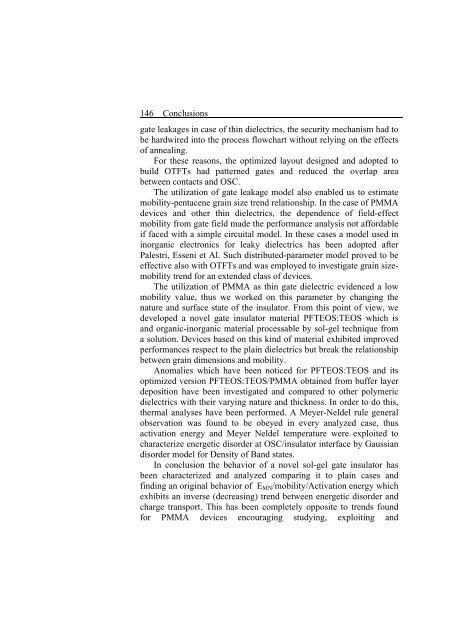tesi R. Miscioscia.pdf - EleA@UniSA
tesi R. Miscioscia.pdf - EleA@UniSA
tesi R. Miscioscia.pdf - EleA@UniSA
Create successful ePaper yourself
Turn your PDF publications into a flip-book with our unique Google optimized e-Paper software.
146 Conclusions<br />
gate leakages in case of thin dielectrics, the security mechanism had to<br />
be hardwired into the process flowchart without relying on the effects<br />
of annealing.<br />
For these reasons, the optimized layout designed and adopted to<br />
build OTFTs had patterned gates and reduced the overlap area<br />
between contacts and OSC.<br />
The utilization of gate leakage model also enabled us to estimate<br />
mobility-pentacene grain size trend relationship. In the case of PMMA<br />
devices and other thin dielectrics, the dependence of field-effect<br />
mobility from gate field made the performance analysis not affordable<br />
if faced with a simple circuital model. In these cases a model used in<br />
inorganic electronics for leaky dielectrics has been adopted after<br />
Palestri, Esseni et Al. Such distributed-parameter model proved to be<br />
effective also with OTFTs and was employed to investigate grain sizemobility<br />
trend for an extended class of devices.<br />
The utilization of PMMA as thin gate dielectric evidenced a low<br />
mobility value, thus we worked on this parameter by changing the<br />
nature and surface state of the insulator. From this point of view, we<br />
developed a novel gate insulator material PFTEOS:TEOS which is<br />
and organic-inorganic material processable by sol-gel technique from<br />
a solution. Devices based on this kind of material exhibited improved<br />
performances respect to the plain dielectrics but break the relationship<br />
between grain dimensions and mobility.<br />
Anomalies which have been noticed for PFTEOS:TEOS and its<br />
optimized version PFTEOS:TEOS/PMMA obtained from buffer layer<br />
deposition have been investigated and compared to other polymeric<br />
dielectrics with their varying nature and thickness. In order to do this,<br />
thermal analyses have been performed. A Meyer-Neldel rule general<br />
observation was found to be obeyed in every analyzed case, thus<br />
activation energy and Meyer Neldel temperature were exploited to<br />
characterize energetic disorder at OSC/insulator interface by Gaussian<br />
disorder model for Density of Band states.<br />
In conclusion the behavior of a novel sol-gel gate insulator has<br />
been characterized and analyzed comparing it to plain cases and<br />
finding an original behavior of EMN/mobility/Activation energy which<br />
exhibits an inverse (decreasing) trend between energetic disorder and<br />
charge transport. This has been completely opposite to trends found<br />
for PMMA devices encouraging studying, exploiting and
















